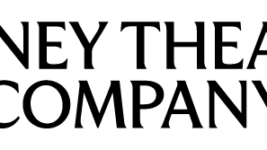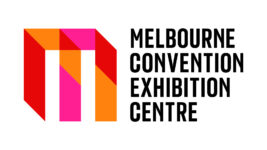THEATRE
14 May 2024
The Lehman Trilogy, Theatre Royal, Sydney
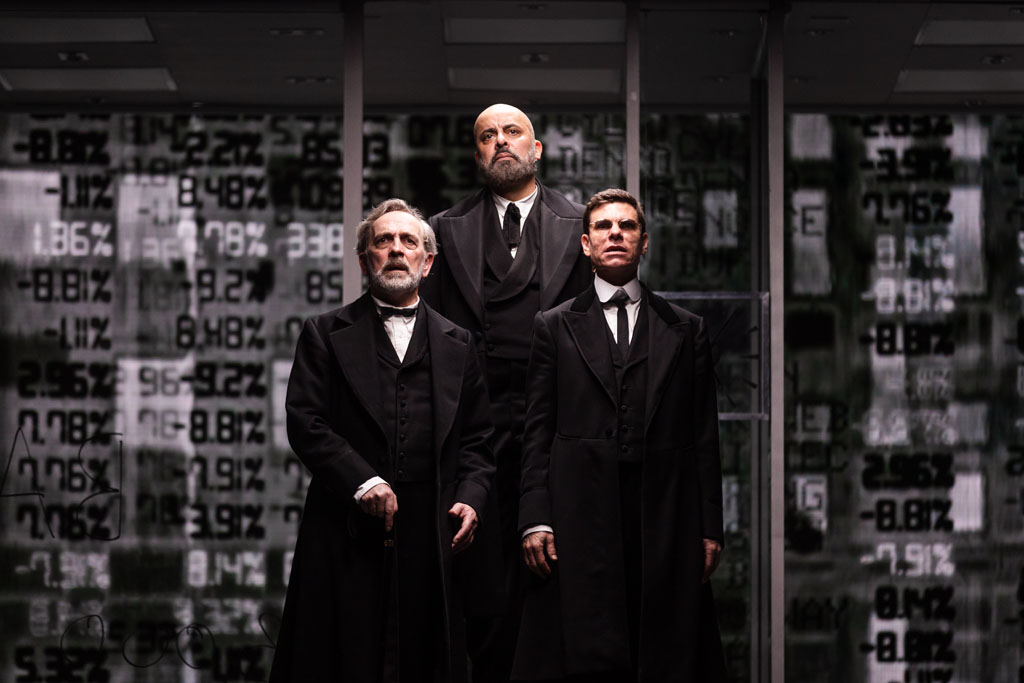
Subscribe to CX E-News
d&b’s Soundscape helps defy the laws of physics
The Lehman Trilogy is a three hour, three-handed epic piece of narrative theatre, telling the story of the Lehman dynasty, a family that arrived in the USA from Germany in 1844.
Starting out as clothing retailers in Alabama, they become traders in cotton (profiting from slavery), moved to New York after the Civil War, become futures traders, and eventually transform into the investment bank that collapsed in 2008, triggering the global financial crisis.
The UK’s National Theatre and Neal Street Productions show is based on a radio play and then novel, originally written in Italian by Stefano Massini. The text was adapted by Ben Power, and the production is directed by Academy, Tony, and Golden Globe winner Sam Mendes. Set design was by Es Devlin, an award-winning multidisciplinary artist and designer.
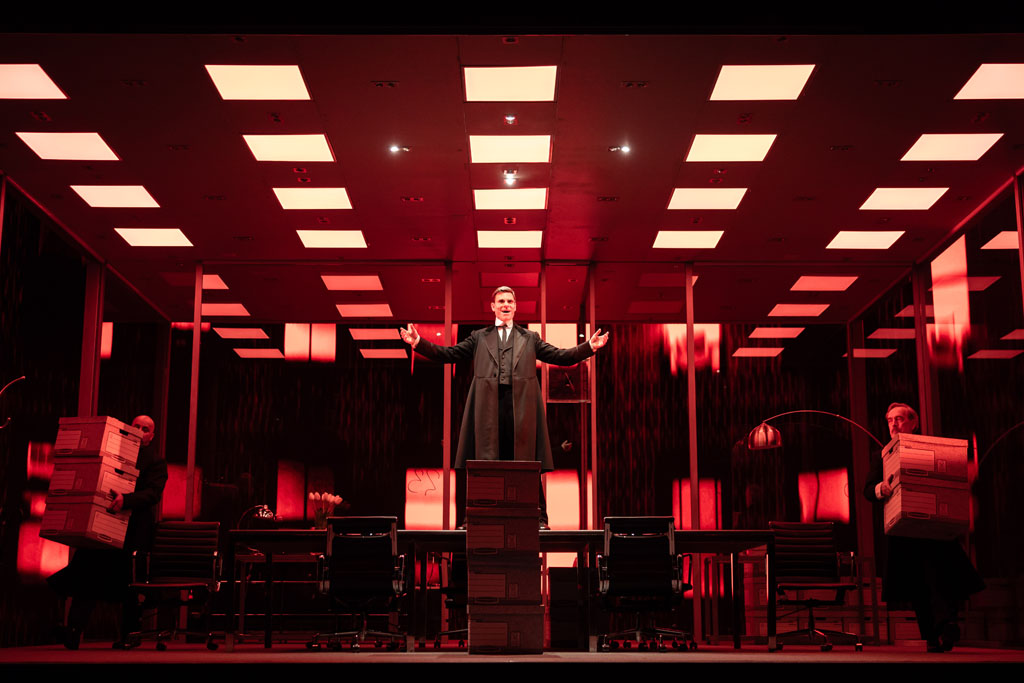
Considering that the Lehman family spent generations indulging in the type of capitalist practices that were unethical, the story humanises multiple generations of Lehmans, with all characters played by just three outstanding actors. The performance I saw in Sydney’s Theatre Royal in March featured Aaron Krohn, Howard W. Overshown, and Adrian Schiller, morphing effortlessly between what amounted to almost 70 characters over three one-hour acts, separated by two intervals.
Vale Adrian Schiller
As The Bard said, “Life’s but a walking shadow, a poor player, that struts and frets his hour upon the stage, and then is heard no more.” Little more than a week after returning from the Sydney run, the exceptionally talented Adrian Schiller, who shone as Henry Lehman, died suddenly aged 60, ending a long and acclaimed career in film, television, and on stage. Though it is no comfort, I believe he bowed out after a triumphant performance.
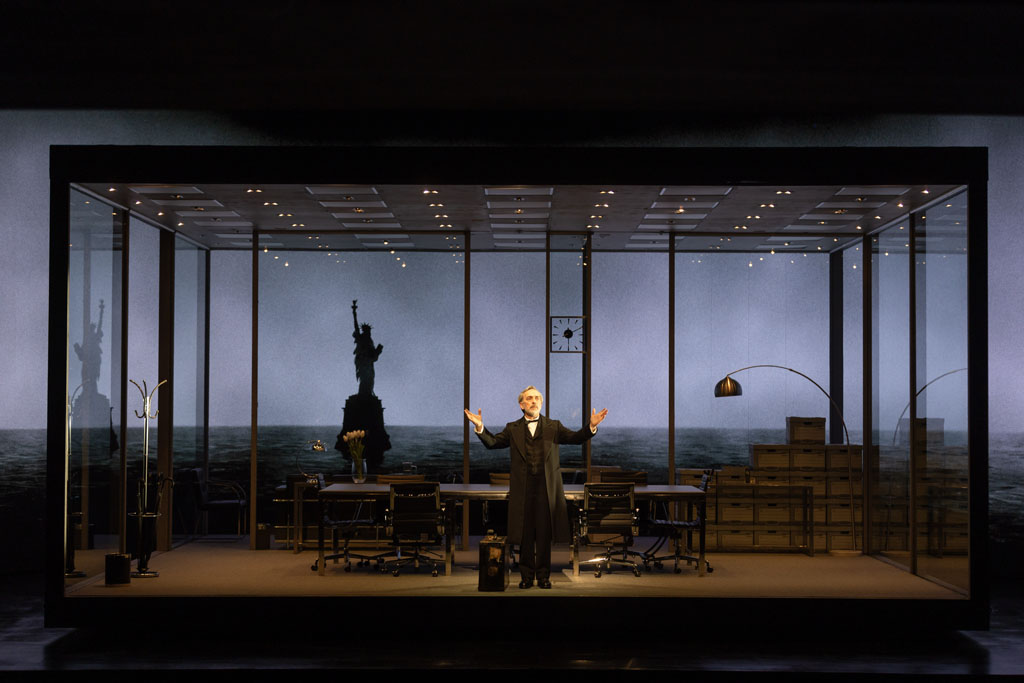
If I hadn’t been there explicitly to experience the sound design, I wouldn’t have noticed the show’s actors were amplified. The Tony and Olivier-award nominated sound design by composer Nick Powell and sound designer Dominic Bilkey is the holy grail of sound in theatre; it’s so perfect, you don’t notice it’s there. It’s all the more an incredible achievement when you notice that the performers act inside a revolving glass box that is only open on two sides.
When the box revolves, the actors continue to speak to the audience straight through solid glass, and still sound exactly the same. Even though I spent almost ten years mixing theatre, it took me a slightly embarrassing amount of time to notice what was happening. A soon as I did, I couldn’t wait to talk to Dominic Bilkey to find out how it was done.
“It is a combination of ZacTrack trackers on the actors and set, d&b Soundscape spatial mixing, and line-by-line fader mixing by the board operators Katie Long or Elliot Wallis,” reveals Dominic. “The acoustic of the glass box is quite interesting as well. You get reflections; you’ve got the curve of the upstage LED video wall, and reflections of the glass walls and ceiling. The acoustic is quite coloured, and interesting challenges exist in that space. On the desk, which is a Yamaha Rivage PM5, there is a lot of dynamic compression working very hard in specific bands. If you look at the compressors when they’re working, the sound tech in you thinks ‘this looks really, really wrong’. But it is right, because what you’re doing is counteracting the glass.”
In term of actor microphones, cast members wear either Sennheiser MKE1s or DPA 6061s, depending largely on their hairline and how the Sound 2, Eliot Wallis could best hide them. Transmit and receive is via Shure Axient Digital.
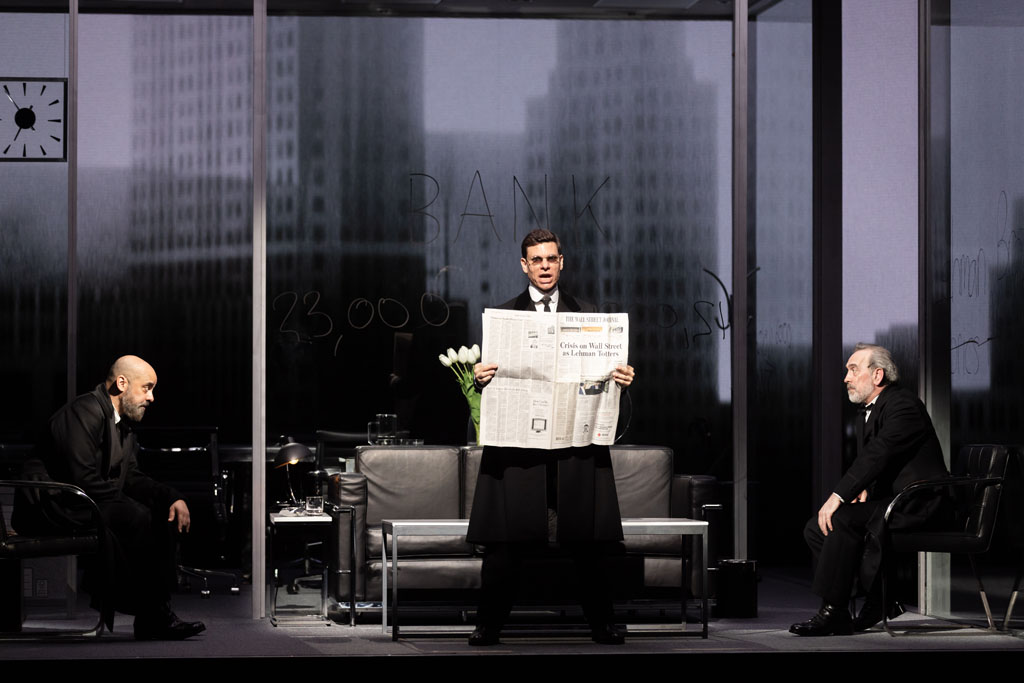
I admit to Dominic that I couldn’t perceive the change in timbre or volume when, mid-speech, a full glass wall and ceiling would pass between the actors and my ears. “As a sound designer, that’s very satisfying to hear,” says Dominic. “When we were on Broadway, the sound position was at the back of the auditorium. At one point, a woman next to me in the audience noticed the same thing, and said to her husband ‘How does that sound the same? They were behind the glass!’ and her husband, without missing a beat, said ‘it’s acoustically transparent glass.’ I almost died, he was so confident; it was perfect!”
Having already been tipped off that Lehman was a d&b audiotechnik design featuring Soundscape spatial processing, I immediately noticed the distributed system throughout the theatre. There were seven hangs of d&b A-Series across the proscenium, augmented by V Subs, with d&b E6s as front fill. A combination of d&b E6s, E5s, and E4s were under balcony fill.
“There were also d&b B22 subwoofers upstage, mainly for low end sound side effects during the Civil War sequence,” Dominic outlines. “There are a pair of d&b V7Ps overhead, and there are speakers in the ceiling of the box for monitoring. In some sequences, we have to send the radio mics to the speakers in the other rooms as the stage rotates so the actors can hear each other. All up, there’s 112 outputs. The rig was a bit of an amalgamation, because TINA, The Tina Turner Musical, had been in there just before us. We translated a lot of the design across then changed the main PA at the front for Soundscape.”
The addition of d&b Soundscape processing through the DS100 Signal Engine has been a huge advantage when touring the show. “The original 2018 production at National Theatre’s Lyttelton Theatre wasn’t Soundscape,” explains Dominic. “It was an LCR d&b T10 system and a complex matrix of panning and delay algorithms in Yamaha DME64 open architecture DSP processors, with a number of them cascaded together. Because the front arrays were hung low enough, everybody was in their coverage, so it was quite successful.”
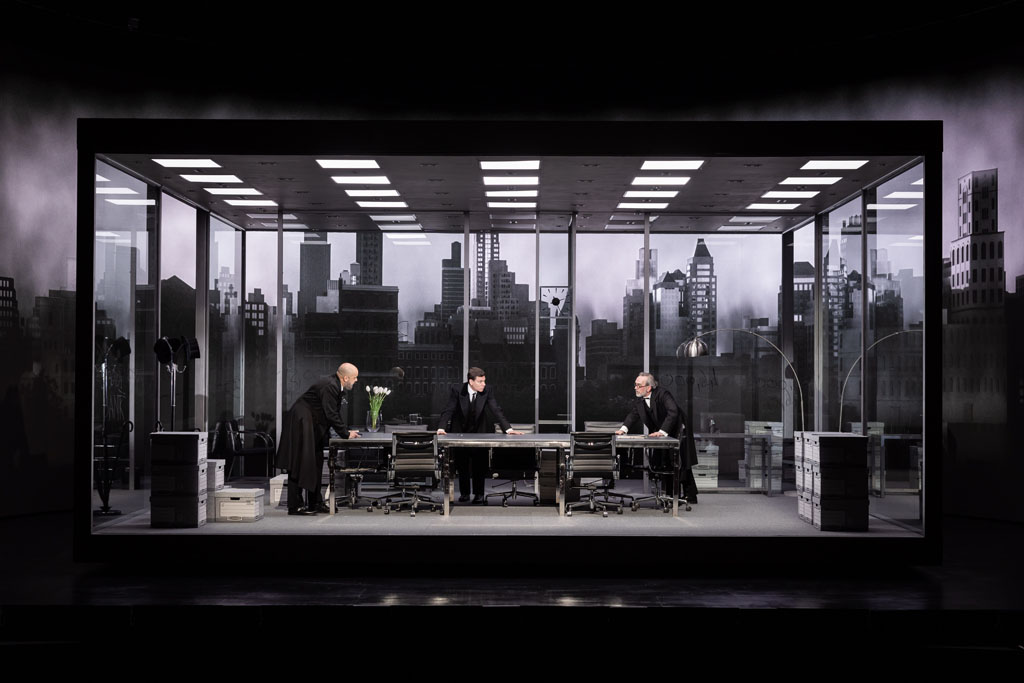
Then the producers announced that show was going to do a run at The Armory in New York. “The Armory is an ex-Army drill hall that’s a block long by a block long; it’s enormous and it’s notorious for acoustics,” Dominic continues. “The width of the seating bank was three times wider than the Lyttelton Theatre, so three arrays weren’t going to cover everyone. There’s a long RT time in The Armory, so then you need delay lines, and then you know LCR is going to be a real challenge. So we made the decision to use Soundscape, which in truth had only just been released. We turned up in New York and put the show into one of its most exclusive venues, having never used Soundscape. As it happened, it worked! And we learned a lot, very quickly!”
It’s testament to Soundcape’s workflow that Dominic and Nick Powell were able to achieve this in such a short amount of time. “There was a moment at the dress rehearsal when I noticed that nobody had mentioned the sound,” Dominic divulges. “No one had said they couldn’t hear anybody, bearing in mind this was in a massive drill hall. The venue had appointed a consultant sound designer familiar with the space to help us with the intelligibility. They came in, sat through the dress rehearsal, walked up to us afterwards and said ‘You don’t need our help’ and that was the last time we saw them. When the show started its run, we had a lot of older audiences asking for assisted listening devices before the show. A lot of them were handed back at the first interval.”

New spatial workflows and capabilities require new tools, and Dominic has been creating them. “Myself and a partner, Jack Lord,have written a piece of software called “Atlas”, states Dominic.
“It allows us to reprogram in a pallet-based reference system. For example, there’s a set of speakers that are above the glass box, which point straight down into the front three rows. Every time the glass box revolves, we found that once the glass is in front of the acoustic source, the image would drop into the front fill. As the glass comes back, the image lifts back up as you get the actor’s acoustic source. So, we added fills that are automated via the ZacTrack tags. As the box revolves, they tell the software that it is revolving, and then that automatically turns the fill speakers on. As the glass passes, it gives a vertical Z-value back to the front row. As the box opens up, and the glass disappears, it turns down again. We can then apply that to every single revolve cue.
Doing that traditionally would be reprogram, reprogram, reprogram, reprogram. Using Atlas, we’ve got one pallet, and the software calls that routine every single time it detects that the cube is revolving. It just tracks through the shows so the operator doesn’t have to hit ‘go’ every time the revolve happens.”
It’s made everything about operating this vast show easier. “The original show file was around 300 positional cues, 200 sound effect cues, and line mixing; it was quite a physical feat for the operator,” admits Dominic. “Now, ZakTrack data goes into Atlas, and takes away some of that ‘manual-ness’. The thing we’ve learned is that if you have the right tools, you can do lots of things very, very quickly. We are making system changes based on things that happen. For example, when the glass revolves, the front fills fade up by one dB, for vocals only. It’s automated; it just happens. With the DS100, you have access to every parameter, and you can change them live. It’s now a question of how adventurous you are feeling.”
In the more physical realm, Dominic and Jack have developed solutions to make bump-ins easier. “It’s interesting to develop tools and ideas to make the spatial workflow possible,” illustrates Dominic. “Because there are a lot more speakers, and measuring where the speakers are in a space takes time, we’ve developed an app called ‘Measure’ that takes the trigonometry from a laser measure. You just point and shoot, and it updates the d&b ArrayCalc software file. These are the tools we need, because you can’t spend four hours measuring speakers; you’ve got to do it in 45 minutes.”
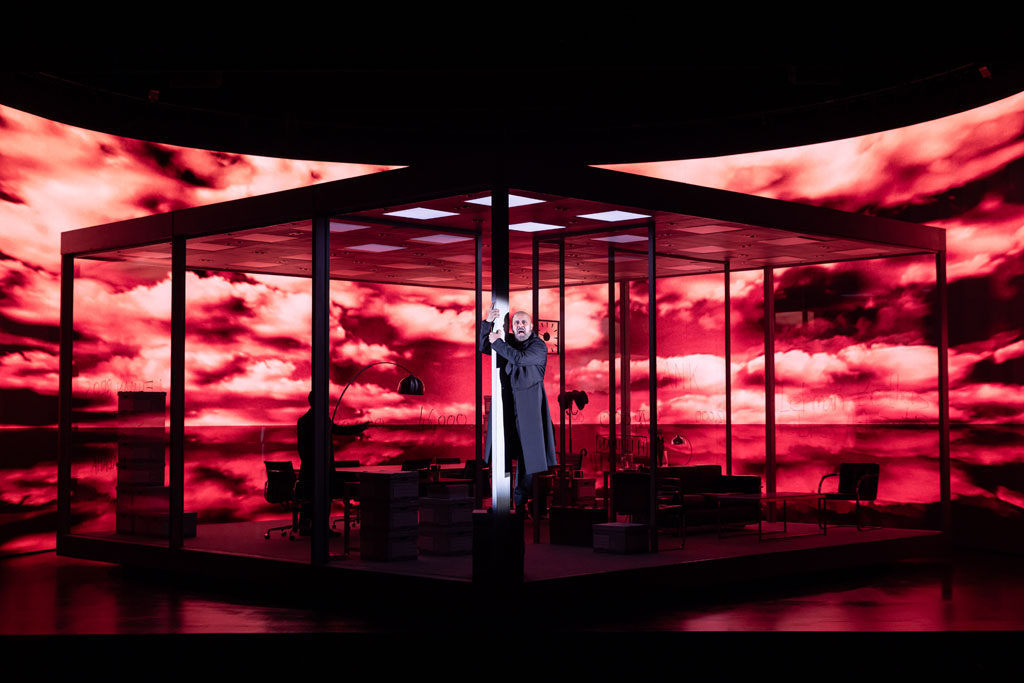
Nick Powell’s compositions, background music cues, and sound design feature a live pianist downstage prompt side, in addition to recorded cues and FX. The adoption of Soundscape has changed how they are approached in the production. “It’s been great bringing Nick Powell on this d&b Soundscape journey,” enthuses Dominic. “Some of the sound effects have evolved into object-based mixing rather than being left-centre-right as originally designed. I’ve learned a lot from Nick through the process as well, because I’m not a musician. Working with the pianists has been fantastic because you get an appreciation for the intricacies of what you can do with just a single piano.”
“Bringing Soundscape into the show has been a joy because it means it’s scalable,” concludes Dominic. “You can go from The Armory, to Broadway, to the Ahmanson in LA, which is a massive space, but you can maintain the intimacy of connection with the dialogue. The show is just three people telling a story.
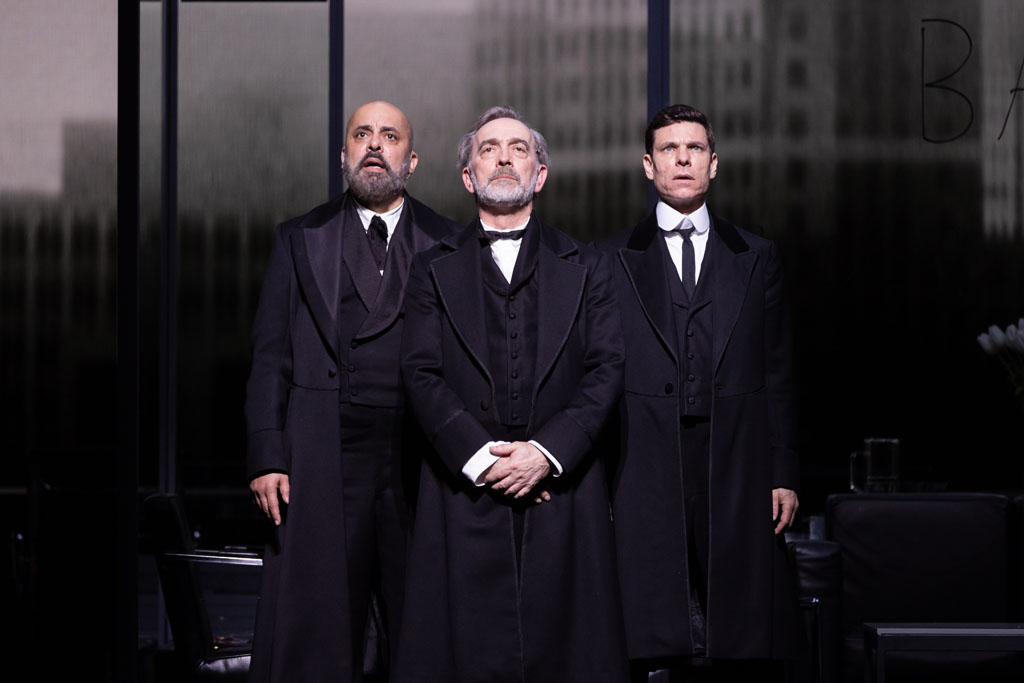
It is epic in scale, but ultimately, it is narrative storytelling. You can succeed putting it into a very big venue because with Soundscape, you maintain the intimacy through localisation. Audiences don’t perceive a ‘traditional’ PA and Soundscape in the same way. It’s a cool system.”
https://www.flamingosoftware.co.uk/
Photos by Daniel Boud
Subscribe
Published monthly since 1991, our famous AV industry magazine is free for download or pay for print. Subscribers also receive CX News, our free weekly email with the latest industry news and jobs.




